Section 6: Likelihood of Release
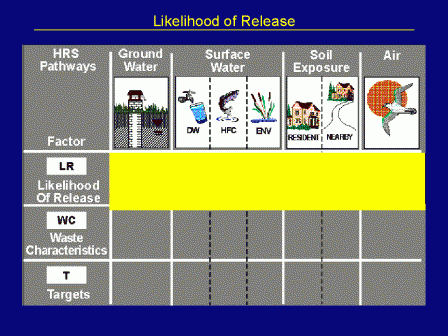
The liklihood of Release (LR) factor category is evaluated based on two factors: observed release and potential to release. If the criteria for an observed release have been met, then the maximum LR value of 550 is assigned to the factor category. An observed release can be documented in two ways:
- direct observation of the release of a hazardous substance from the site into ground water, surface water, or air (as applicable).
- chemical analysis of ground water, surface water, or air samples (as applicable) that indicate the presence of a site-related hazardous substance at a level significantly above background.
If an observed release is established through either of these criteria, potential to release is not evaluated. If no observed released can be established, the site is scored on potential to release only (maximum value: 500 points). The procedures for determining potential to release are pathway-specific and will be addressed separately for each pathway.
6.1 Observed Release
An observed release means that hazardous substances have been documented to have entered the media of concern and that the release is attributable, at least in part, to the site that is being evaluated. The Hazard Ranking System (HRS) Guidance Manual, Section 5.1, page 55 provides definitions for Observed Release and Attribution along with other key terms. Attribution is an important concept that will be discussed below.
- Observed Release by Direct Observation
- Observed Release by Chemical Analysis
- Significance Above Background
- Background
- Selecting Appropriate Background Samples
- Establishing Background Levels without Sampling
- Attribution
- Transformation Products
Generally, a one-time occurrence of an observed release is sufficient to justify assigning the maximum LR value based on the establishment of an observed release. Thus, for example, if an observed release has been established by chemical analysis of samples, subsequent samples showing no increase above background do not negate the original observed release. The principal exception to this policy occurs when significant action has been taken at the site so as to preclude a reoccurrence of the release.
Observed Release by Direct Observation
Observed release can be established for the ground water, surface water, or air migration pathways either by chemical analysis or direct observation. An observed release by direct observation to ground water is established whenever evidence indicates that a material known to contain hazardous substances has been deposited directly into an aquifer or has been observed entering an aquifer. Documentation must substantiate that the hazardous substance is present in the material observed being released.
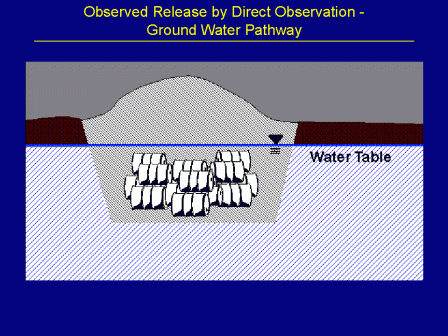
The above graphic illustrates how an Observed Release (OR) can be documented by direct observation for the ground water pathway. It shows that material containing hazardous substances was dumped into a landfill. (There are manifests or other documentation of what is in the drums.) After the drums were deposited and covered over, the water table was reestablished above the level of the drums. The drums and hazardous substances are now in the shallow aquifer.
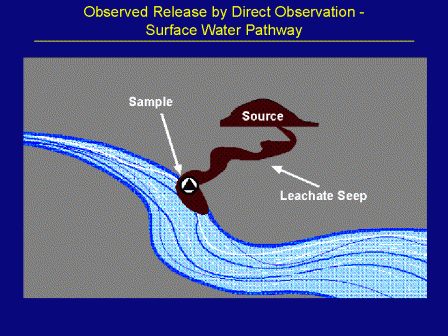 This illustration shows an observed release by direct observation to the surface water pathway. A leachate seep from the impoundment (source) can be seen entering the stream. A leachate sample taken close to the stream shows that the seep contains hazardous substances associated with the impoundment. Note that the sample was taken from the leachate, not the surface water.
This illustration shows an observed release by direct observation to the surface water pathway. A leachate seep from the impoundment (source) can be seen entering the stream. A leachate sample taken close to the stream shows that the seep contains hazardous substances associated with the impoundment. Note that the sample was taken from the leachate, not the surface water.
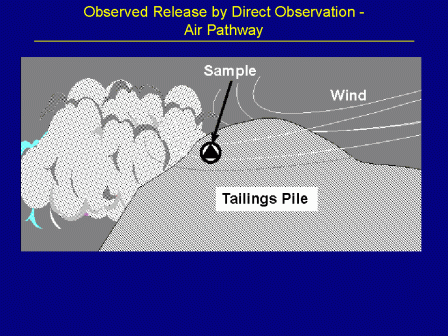 The above graphic illustrates how an observed release to the air pathway can be documented by direct observation. In this example a dust cloud is blowing from a tailings pile, and a sample of fine particles from the pile shows hazardous substances to be present. The dust cloud constitutes the "observed" release, while the particle samples establishes that the cloud contains hazardous substances.
The above graphic illustrates how an observed release to the air pathway can be documented by direct observation. In this example a dust cloud is blowing from a tailings pile, and a sample of fine particles from the pile shows hazardous substances to be present. The dust cloud constitutes the "observed" release, while the particle samples establishes that the cloud contains hazardous substances.
Observed Release by Chemical Analysis
The other method of establishing an observed release is through chemical analysis of media samples. An observed release is demonstrated whenever these samples show the presence of contamination significantly above background levels, some part of which is attributable to the site.
It is essential that samples used to document observed releases by chemical analysis be representative of the medium sampled. Care must be taken to ensure that the release was not actually caused by the action of sampling or other investigation activities. Most sampling protocols are designed to ensure representativeness and avoid site disturbances. For example, field teams must ensure that ground water monitoring wells have been appropriately completed, purged, and otherwise properly installed so that samples accurately reflect aquifer conditions. Surface water sampling should begin at the most downstream location and proceed upstream. Similarly, aqueous samples should be collected before sediment samples (during the same sampling event). Air sampling stations must also be situated so as not to collect samples contaminated by sampling equipment motors and gases. Guidance on sampling methods is available in the Environmental Response Team's Superfund Program Representative Sampling Guidance Documents. Further discussion on the need for representative sampling and data quality objectives in general can be found in the following:
U.S. Environmental Protection Agency, 1987, Data Quality Objectives for Remedial Response Activities — Development Process, (EPA/540/G-87-003 OSWER Directive 9355.0-7B), U.S. Environmental Protection Agency, Washington, DC, March.
U.S. Environmental Protection Agency, 1989, Guidance on Applying the Data Quality Objectives Process for Ambient Air Monitoring Around Superfund Sites (Stages I & II), (EPA-450/4-89-015), U.S. Environmental Protection Agency, Research Triangle Park, NC, August.
U.S. Environmental Protection Agency, 1992, Guidance for Data Usability in Risk Assessment (Part A) Final, (Publication: 9285.7-09A), U.S. Environmental Protection Agency, Washington, DC, April.
U.S. Environmental Protection Agency, 1993, Guidance for Planning for Data Collection in Support of Environmental Decision Making Using the Data Quality Objectives Process, (EPA QA/G-4), U.S. Environmental Protection Agency, Washington, DC, October 6.
Above it was stated that for a chemical analysis to document an observed release, it must show contamination "significantly" above the background level. The HRS Rule, Table 2-3, page 51589 defines what is "significant" in HRS terms. In summary, the HRS provides that:
If the sample measurement is less than the applicable quantitation limit then no observed release is established with that sample.
An observed release is demonstrated whenever:
- the background concentration is less than the detection limit and the sample concentration exceeds the applicable quantitation limit; or
- the background concentration equals or exceeds the detection limit and the sample concentration is 3 times or more above the background concentration.
The applicable quantitation limit is defined according to the following hierarchy:
- sample quantitation limit (SQL)
- EPA contract-required quantitation limit (CRQL) if the sample analysis was performed under the EPA Contract Laboratory Program
- detection limit
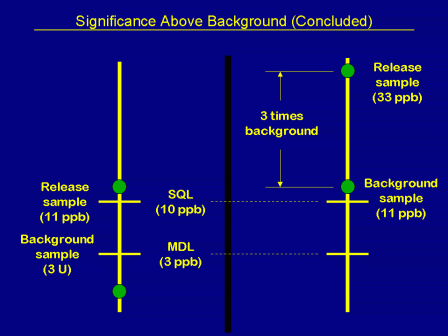
In the center of the diagram the SQL and the Method Detection Limit (MDL) are identified.
The diagram on the left illustrates a release sample that is above the SQL, with a non-detect background (the U qualifier denotes non-detect). The observed release criteria are satisfied.
The diagram on the right illustrates a release sample that is exactly three times above the SQL. Since this is a detect background, which requires the sample measurement to be at least three times greater than the background concentration, the observed release criteria are satisfied.
Guidance on defining "background" can be found in the HRS Guidance Manual, Section 5.2. The definition of "background" is provided and clarified as follows:
- "Concentration of a hazardous substance that provides a defensible reference point that can be used to evaluate whether or not a release from the site has occurred."
- "The background level should reflect the concentration of the hazardous substance in the medium of concern for the environmental setting on or near a site."
- "Background level does not necessarily represent pre-release conditions, nor conditions in the absence of influence from source(s) at the site."
- "A background level may or may not be less than the detection limit, but if it is greater than the detection limit, it should account for variability in local concentrations."
- "A background level need not be established by chemical analysis."
It is important to note that this definition differs significantly from the commonly understood concept of "background." The common concept of "background" focuses on contamination (either natural or anthropogenic) that is present exclusive of that arising from some identified activity. The HRS definition of "background" focuses on the criteria necessary to establish an observed release. In practice, the two concepts may correspond but they are not required to.
- If there is detectable contamination in the background, then the background level selected should account for variability in local conditions. This is necessary to avoid identifying normal variation in natural or anthropogenic background concentrations as "observed releases," a possibility whenever the range of the background concentrations equals or exceeds a factor of three. In order to avoid this occurrence, multiple samples may be required to establish the background level.
- Background samples are the usual way to establish the background levels of substances in environmental media, but they are not the only way. Determining background levels without sampling will be discussed later in this section.
- Background samples do not have to be "clean" or "non-detect." Sometimes the background for a substance is "noisy." In otherwords, the background samples show contamination. Examples of such contamination include metals in soil sediments (especially in mining districts); trichloroethene (TCE) in urban surficial aquifers (as in the Silicon Valley, California and the Biscayne Aquifer in Florida); and perchloroethylene (PCE) or TCE in rivers (especially in heavily industrial areas).
- It is not necessary to establish that the site being evaluated is the only source of contamination, only that the site has significantly increased the level of contamination compared to background.
Selecting Appropriate Background Samples
In selecting background samples to establish background level by chemical analysis, the background and release samples must be similar so that analytical results can be compared for "significance" above background. Therefore, descriptions of the sampling locations and procedures are needed to establish similarity between background and release samples.
Examples of samples that should not be compared:
- Filtered versus unfiltered ground water samples.
- Ground water samples taken from significantly different depths within an aquifer.
- Samples taken from different soil horizons.
- Samples taken from different flow regimes within a stream.
- Sediment samples versus aqueous samples.
- Dissimilar tissue samples (the age, sex, and species should be similar).
- Samples taken a significant time period apart.
Documentation should be provided to justify why the background and release samples are similar enough for comparison. The nature and extent of the documentation required depends on the medium of concern and the potential dissimilarity of the samples. The most common similarity problem is presented by samples taken at different times. Samples taken at different times can be compared only if it can be shown that the time-scale of change within the medium of concern is greater than the time-difference between the samples. Thus, larger time differences are sometimes acceptable for a fairly static medium (such as soil) but not for a rapidly changing medium (such as air). Spatial heterogeneity is also an issue when comparing samples. For example, ground water samples taken across a water table should not be compared with deep ground water samples because of the possibility for missing floaters or sinkers. Overall, the degree of homogeneity within the medium of concern will largely determine when two samples are sufficiently similar for comparison.
See the HRS Guidance Manual, Section 5.2, page 67 for guidance on selecting appropriate background samples.
Establishing Background Levels Without Sampling
Background samples should be collected to establish a background level whenever possible, because they also help to establish attribution of releases to the site. However, as stated above, the HRS does not require a background sample to establish a background level. At some sites, it may not be possible to conduct background sampling. At these sites, it may be necessary to establish the background level based on published data relevant to the site. The HRS Guidance Manual, Section 5.1, pages 62-63 provides guidelines on using published data to establish a background level.
As stated in the HRS Guidance Manual, Section 5.1, pages 59 and 61, two types of information are sufficient to attribute the hazardous substance found in an observed release to the site: site documentation (e.g.,manifests, written statements, interviews with employees) and analytical sampling data. Site documentation, which is often available during field activities, should give the location of potential alternative sources so that appropriate background sample locations can be chosen.
Background samples are often required to establish attribution when there are possible alternative sources near the site. This is done by taking background samples from between the alternative sources and the site so that it can be demonstrated that the release sample is significantly elevated above background, including the contribution of the alternative source.
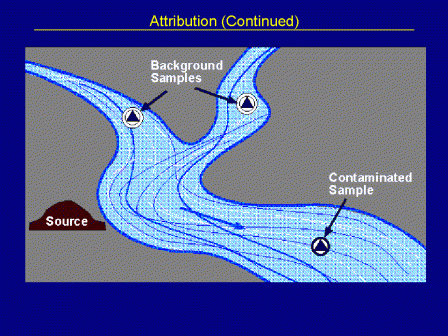 The above example shows a site located along a surface water body. In this instance, there are two background samples located upstream from the possible source, and a contaminated (release) sample located downstream from the possible source.
The above example shows a site located along a surface water body. In this instance, there are two background samples located upstream from the possible source, and a contaminated (release) sample located downstream from the possible source.
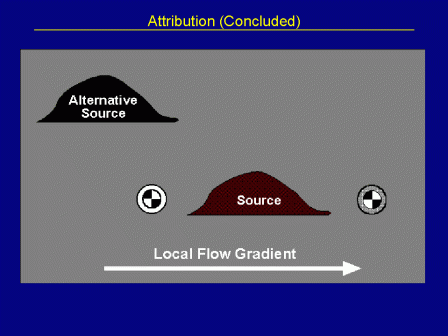 This example shows two neighboring sites, each with one source (surface impoundments) than contain similar hazardous substances. There has been a release to the ground water, which is suspected of coming from the southern most(bottom) site. The eastern (to the right) well produced a contaminated sample. Samples from the western (on the left) well are clean, representing the background sample. The local flow gradient is from west to east.
This example shows two neighboring sites, each with one source (surface impoundments) than contain similar hazardous substances. There has been a release to the ground water, which is suspected of coming from the southern most(bottom) site. The eastern (to the right) well produced a contaminated sample. Samples from the western (on the left) well are clean, representing the background sample. The local flow gradient is from west to east.
Some hazardous substances found in the environment from release samples may be different from those documented in a source at a site. This may result from a transformation of the substances originating from the source (the parent substances) by physical, chemical, and/or biological processes that occur when the substances are exposed to the environment. The resulting substances found in the environment are called "transformation products." There are two kinds of transformation products:
- a less complex transformation product is called a degradation product
- a more complex transformation product is called a formation product
Highlight 5-9 of the HRS Guidance Manual, Section 5.3 lists some typical degradation products and their parent substances. At a site inspection, sample analyses for likely transformation products should be made. If the transformation products are found in the analyses, both the parent and transformation substances should be attributed to sources at the site, as outlined in the HRS Guidance Manual, Section 5.3.
Transformation product relationships play an important role in observed release demonstrations. It is not always possible to directly attribute a substance detected in a release to a site simply because the substance was never present at the site. Nonetheless, it may be possible to attribute the release if the substance is a transformation product of another substance known to be at the site. Possibly the most common example of this situation concerns vinyl chloride. Vinyl chloride is a gas at ambient temperatures and pressures and, as a result, was rarely deposited in sites. Vinyl chloride is commonly found at sites, however, because it is a degradation product of trichloroethylene (TCE). It is possible, depending on other factors, to attribute a release of vinyl chloride to a site based on a history of TCE deposition at the site, even though TCE was detected significantly above background. So, if release samples contain substances that do not appear in the source, the possibility of an observed releases should not necessarily be discounted. The HRS Guidance Manual, Section 5.3. provides guidance for establishing an observed release based on transformation products.
6.2 Potential to Release
In the absence of an observed release, potential to release can be evaluated in the three migration pathways. Potential to release is not evaluated in soil exposure pathway. The potential to release value reflects the likelihood of hazardous substance migration from the site to the medium of concern in the absence of an observed release. As discussed in Section 3 - Likelihood of Release of this training course, potential to release is assessed in each migration pathway based on two types of factors: hazardous substances associated with a source and sources with non-zero containment. The following lists the factors used in each migration pathway.
Ground Water Pathway
- Ground Water Containment
- Net Precipitation
- Depth to Aquifer
- Travel Time
Air Pathway
- Gas
- Gas Containment
- Gas Source Type
- Gas Migration Potential
- Particulate
- Particulate Containment
- Particulate Source Type
- Particulate Migration Potential
Surface Water Pathway
- Overland Flow
- Surface Water Containment
- Runoff
- Distance to Surface Water
- Flood
- Flood Containment
- Flood Frequency
- Ground Water to Surface Water
- Ground Water Containment
- Net Precipitation
- Depth to Aquifer
- Travel Time
The maximum potential to release value is 500 in all migration pathways.
6.3 Questions and Answers
Would a photograph of a source inundated during a flood establish an observed release to the surface water?
Yes, if the source was documented to contain hazardous substances.
What kind of information could you use to show that sediment samples are similar?
Sampling location (depth, position in stream, etc.), grain size, sampling date, etc.
Do the two background samples adequately address attribution?
Yes, because the background samples are placed between the suspected source and any alternative sources, which may exist further upstream. Thus, in judging whether the release sample is significantly elevated above background, the background measurement will already account for the contribution of any alternative sources. This allows the scorer to isolate the impact of the suspected source in attributing it to any contamination.
Do the two background samples still adequately address attribution?
No, because the background samples are no longer placed between the suspected source and the alternative source. Thus, in judging whether the release sample is significantly elevated above background, the background measurement will not account for any possible contribution of the alternative source. This prevents the scorer from isolating the impact of the suspected source in attributing it to any contamination.
Can an observed release be documented for the source at the bottom site?
No. An attribution sample located between the two sources is needed because it is not possible to determine ground water flow from two points. Because of possible subterranean obstructions, the flow depicted on this graphic may only be a component vector of the actual flow.
What information is needed in order to document an observed release from a site?
- Recorded information documenting that a substance attributable to the site has been entering the media of concern (Direct Observation); or
- The detection in the media of one or more hazardous substances attributable to the site with concentrations significantly above background levels. The "significant increase" has to be at least partially attributable to the site.
If an observed release cannot be documented, how will it affect the site score?
Because the maximum value for potential to release is 500 and an observed release is assigned a factor value of 550, potential to release will always have a lower score. Also, because actually contaminated (Level I or II) targets cannot be evaluated without an observed release, the target values will also be significantly lower.
How does the HRS define significance above background for documenting an observed release?
If the background is non-detect, any release sample above the detection limit qualifies as a significant increase above background. If the substance is detected in the background sample, the release sample concentration must be at least three times greater than the background level.
When might attribution samples be needed?
Attribution samples may be needed when there is a possible alternative source of the same hazardous substance being examined at the site.
Navigate to another section of the course:
| Table of Contents | |||||||||
|---|---|---|---|---|---|---|---|---|---|
| 1 | 2 | 3 | 4 | 5 | 6 | 7 | 8 | 9 | 10 |
| 11 | 12 | 13 | 14 | 15 | 16 | 17 | 18 | 19 | 20 |
